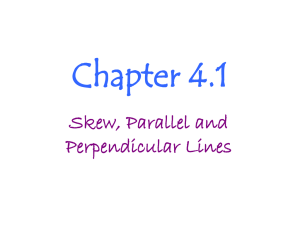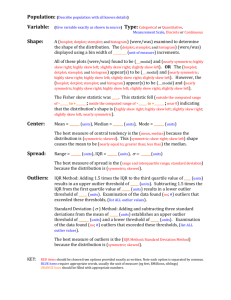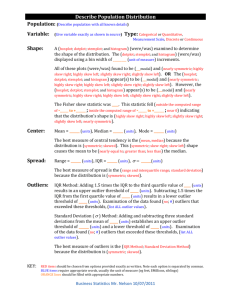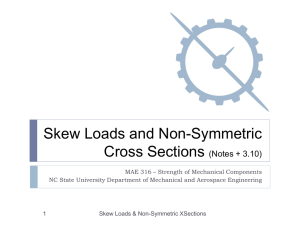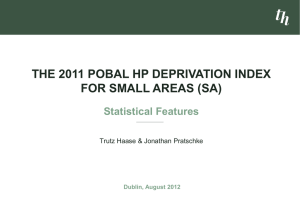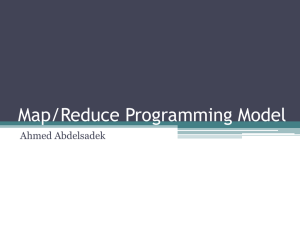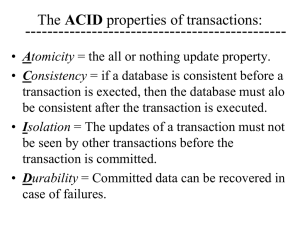SkewTune: Mitigating Skew in MapReduce Applications
advertisement
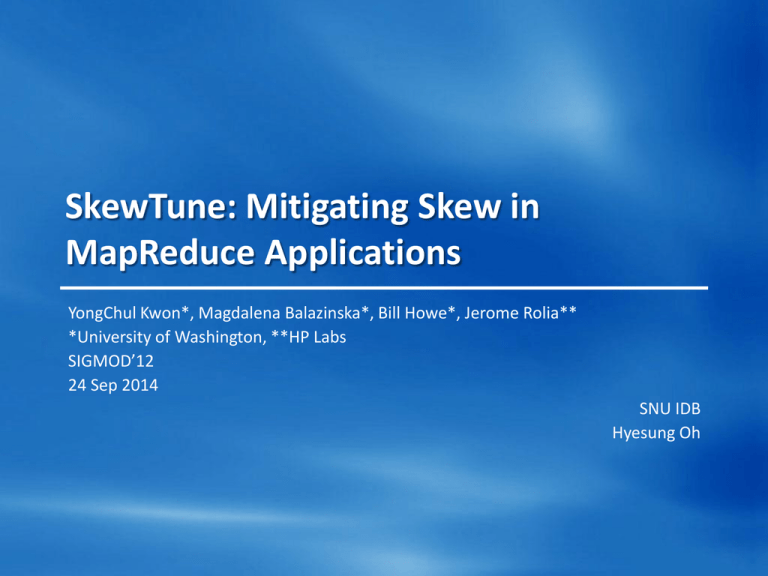
SkewTune: Mitigating Skew in MapReduce Applications YongChul Kwon*, Magdalena Balazinska*, Bill Howe*, Jerome Rolia** *University of Washington, **HP Labs SIGMOD’12 24 Sep 2014 SNU IDB Hyesung Oh Outline Introduction – UDOs with MapReduce – Types of skew – Past Solutions SkewTune – – – – – Overview Skew mitigation in SkewTune Skew Detection Skew Mitigation SkewTune For Hadoop Evaluation – Skew Mitigation Performance – Overhead of Local Scan vs. Parallel Scan Conclusion <2/18> Introduction User-defined operations(UDOs) – Transparent optimization in UDO Programming -> key goal! <3/18> UDOs with MapReduce MapReduce provides a simple API for writing UDOs – Simple map and reduce function – Shared-nothing cluster Limitations of MapReduce – Skew causes slowing down entire computation • Load imbalance can occur map or reduce phases • Map-skew • Reduce-skew A timing chart of a MapReduce job running the PageRank algorithm from Cloud 9 – case of map-skew <4/18> Types of skew First type : uneven distribution of input data Input data 1 (large) Mapper 1 Input data 2 Mapper 2 Second type : some portions of the input data taking longer process time Elapsed Time 0 1 Mapper 2 <5/18> 2 3 Mapper 1 4 5 Past solutions Special skew-resistant operators – Extra burden to UDOs – Only applies to operations that satisfy properties Extremely fine-grained partitions and re-allocating – Significant overhead State migration Extra task scheduling Materializing the output of an operator – Sampling output and Plan how to repartition it – Requires a synchronization barrier between operators Preventing pipelining and online query processing <6/18> SkewTune New technique for handling skew in parallel UDOs Implemented by extending Hadoop system Key features – Mitigates two types of skew Uneven distribution of data Taking longer to process – Optimize unmodified MapReduce programs – Preserves interoperability with other UDOs – Compatible with pipelining optimizations Does not require any synchronization barrier <7/18> Overview Coordinator-worker architecture – On completion of a task, the worker node requests a new task from the coordinator Coordinator Worker 1 Worker 2 De-coupled execution – Operators execute independently of each other Independent record processing Per-task progress estimation – Remaining time Per-task statistics – Such as total number of (un)processed bytes and records <8/18> Skew mitigation in SkewTune Conceptual skew mitigation in SkewTune <9/18> Skew Detection Late Skew Detection – Tasks in consecutive phases are decoupled – Map tasks can process their input and produce their output as fast as possible – Slow remaining tasks are replicated when slots become available Identifying Stragglers – Flags skew 𝑡𝑟𝑒𝑚𝑎𝑖𝑛 2 > 𝜔 𝑡𝑟𝑒𝑚𝑎𝑖𝑛 : time remaining(seconds), 𝜔 : repartitioning overhead(seconds) <10/18> Skew Mitigation - 1 SkewTune uses range partitioning – To preserve original output order of the UDO Stopping a straggler – Straggler captures the position of its last processed input record Allowing mitigators to skip previously processed input – If straggler is impossible or difficult to stop Request fails and the coordinator selects another straggler <11/18> Skew Mitigation - 2 Scanning Remaining Input Data – Requires inform about the content of data Coordinator needs to know the key values that occur at various points in the data – SkewTune collects a compressed summary of the input data The form of a series of key intervals – Choosing the Interval Size |S| : total number of slots in the cluster ∆ : the number of unprocessed bytes 𝑠= ∆ 𝑘∗ 𝑆 Lager values of k enable finer-grained data allocation to mitigators – Also increase overhead by increasing the number of intervals and size of the data summary – Local Scan or Parallel Scan If the size of the remaining straggler data is small -> local scan Else <12/18> Skew Mitigation - 3 Planning Mitigators – The goal is to find a contiguous order-preserving assignment of intervals to mitigators – Two phases Computes the optimal completion time – The phase stops when a slot assigned less then 2w work – 2w is the largest amount of work such that further repartitioning is not beneficial Sequentially packs the intervals for the earliest available mitigator <13/18> SkewTune For Hadoop <14/18> Evaluation Twenty-node cluster – – – – – Hadoop 0.21.1 2 GHz quad-core CPUs 16GB RAM 750GB SATA disk drive HDFS block size 128MB Following applications – Inverted Index Full English Wikipedia archive – Page Rank Cloud 9, 2.1GB – CloudBurst MapReduce implementation of the RMAP algorithm for short-read gene alignment 1.1GB <15/18> Skew Mitigation Performance Ideal case, SkewTune has overhead – Extra latency compared with ideal are scheduling overheads – An uneven load distribution due to inaccuracies in SkewTune’s simple runtime estimator <16/18> Overhead of Local Scan vs. Parallel Scan <17/18> Conclusion SkewTune requires no input from users Broadly applicable as it makes no assumptions about the cause of skew Preserving the order and partitioning properties of the output 4X improvement over Hadoop Good Paper <18/18>
